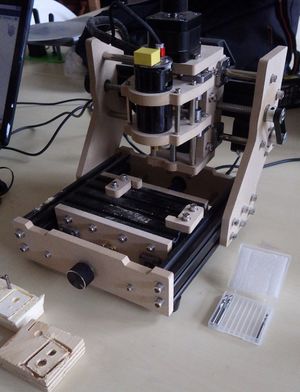CNC Mill
From CoMakingSpace Wiki

A CNC mill is similar to a CNC router, but usually more precise and designed for smaller workpieces.
?Kress CNC
Sebastian bougt a sturdy homemade cnc mill for cutting harder materials harder materials than the workbee is capable of.
| MachineInfoBox ?Kress CNC | |
|---|---|
| File:Https://user-images.githubusercontent.com/87819637/173250672-8c92d1d4-b864-40ca-bfaa-3f1d7a5e0f06.jpg | |
| Material: | wood, metal |
| Used with: | endmills |
| Access Requirements: | CNC Mill Introduction |
| Tutors: | Luzian Sebastian |
| Similar (More or Less): | CNC router |
EleksMill
| MachineInfoBox EleksMill | |
|---|---|

| |
| Synonyms: | DE: CNC-Fräse |
| Material: | just foam for now |
| Used with: | 1/8" endmills |
| Access Requirements: | CNC Mill Introduction |
| Software: | CAD/CAM software (e.g. Fusion 360); G-code sender |
| Tutors: | Luzian Sebastian |
| Similar (More or Less): | CNC router |
Mitja brought his "EleksMill" into our common room - it's small, but great for learning the basics of CNC milling! Talk to him or a manager if you are interested in using it.
Important Facts
- 130 × 90 × 40 mm working range (less Z freedom depending on the length of your endmill!)
- there are no endstops
- manually home the mill before a job
- you should use the (X/Y center, Z surface) as your origin
- make sure the size of your part does not exceed the working range!
- motor speed: ???
- compatible shaft diameter: 1/8" (3.175 mm)
- controlled like the CNC router (Fusion 360 or similar CAD/CAM software; G-code sender)
- connection via USB - bring your own laptop!
Workholding
The mill has a 150 × 98 mm bed containing of 4 T-slots. clamping claws or similar workholders can be attached to it using M5 screws.
The current solution is not ideal, but many the workholding options for our larger CNC router should also be suitable if scaled down.
TO DO
- figure out motor speed to calculate proper feedrates
- what else?
Past Issues
- screws/nuts used to come loose due to vibrations
- fixed with loctite or counternuts (where possible)
- Z axis used to be too hard to turn => mill drifted deeper and deeper into the workpiece as upwards movements failed but downward movements were still possible
- was caused by a faulty spring